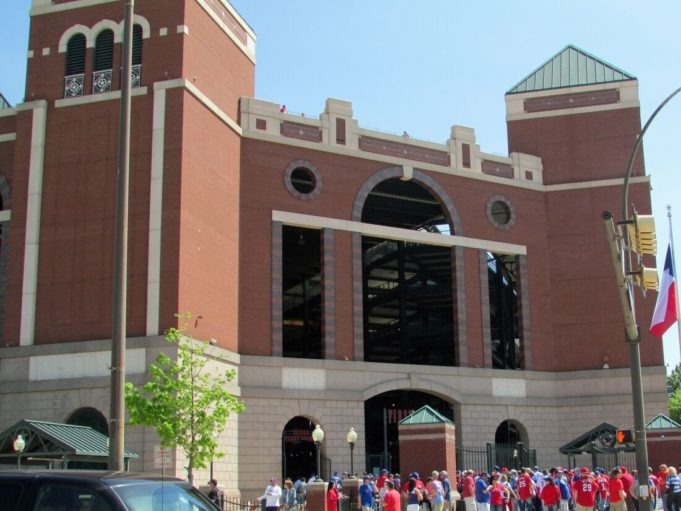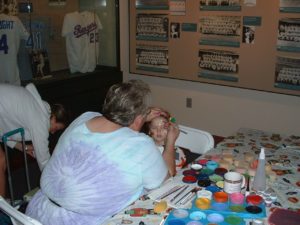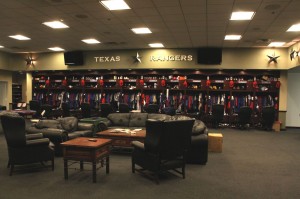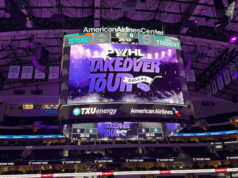In a about a month, a plurality of voting-age Arlingtonians will likely decide whether or not to set an end date for Globe Life Park in Arlington’s tenure as a baseball venue. Many believe it should still have decades of life ahead of it as a viable baseball facility. Others think its days numbered because it lacks air conditioning or a 75202 zip code.
Some opponents of the new stadium subsidy oppose it in part because the Rangers have done a good job of servicing the facility Arlington taxpayers built for them in 1994. In fact, the franchise has done more than maintain it. They have consistently made changes and tried new features aimed at keeping the facility productive as it has aged. So the ballpark a successful Vote Yes campaign phases out wouldn’t necessarily be a static 90s relic. Some memorable additions/deletions include, in no apparent order :
Name
Since beginning in Washington, D.C. in 1961, the franchise has played in four ballyards. Those stadia have had a total of nine names. They went from Griffith Stadium and D.C. Stadium/Robert F. Kennedy Stadium to Turnpike/Arlington Stadium. Then their current home started as The Ballpark in Arlington and has morphed into Ameriquest Field in Arlington, Rangers Ballpark in Arlington, and Globe Life Park in Arlington. In all cases, the bases have remained 90 feet apart and the pitcher’s mound has stayed 60 feet, 6 inches from home plate.
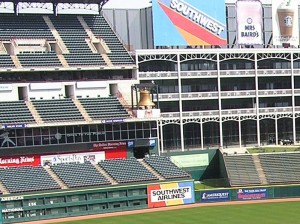
The Bell
My enduring memory of the team’s first naming rights deal is a promotion I did while I was with the team called The Ameriquest Mortgage Company Spotlight on Youth Baseball and Softball. Everyone else thinks of the bell. The big faux metal construction in left field rang electronically for various Rangers on-field accomplishments. The team had removed seats to add the contraption. Luckily they hadn’t gotten rid of them and the maintenance department could reinstall them once the naming rights deal ended in 2007.
The South Side
When the place opened, it had a sports art gallery, a museum, a ticket office, and some retail shops along its south-facing facade. It still has a ticket office and spots to buy stuff. When the team expected to close Randol Mill as part of the ill-fated Glorypark development, it moved the primary ticket office near the home plate gate. It has since kinda moved back.
The Museum’s demise crushed me. Part of it was personal because I had put a lot of work into trying to update its video exhibits with no budget. Part of the angst came because, as a baseball fan, it was hard to conceive of a scenario where a team possessed artifacts owned by the likes of Babe Ruth and loaned by the Baseball Hall of Fame and couldn’t figure out a way to take advantage of them. They just sent them all back to Cooperstown. The current Rangers Hall of Fame in that space offers a lot more room for hospitality events, but it lacks priceless artifacts and an effective means to educate schoolchildren about the history of the national pastime. Plus they used to host a fun Halloween event called Batty at The Ballpark like the one in the photo that my now-teenaged niece will be so excited I used.
Vandergriff Plaza
The area beyond center field has seen lots of changes. Toby Mendez-sculpted statues of Nolan Ryan and Tom Vandergriff were added in 1997. The Coca-Cola Sports Park offered kids a chance to hit wiffle balls and enjoy other basebally activities. The Budweiser Bowtie concession area now occupies that space and the kids area has moved into the old gift shop and some of the former KRLD studio space next to the center field gate. The Captain Morgan Club takes up the rest of the old studio and the Hyundai Club has replaced the former brick batter’s eye.
Fox Set in Left Field
Fox Sports Southwest used to host its pre- and postgame shows from a set in the left field vomitorium. They moved into the Captain Morgan Club in 2012.
Statuary
In 2012, the Rangers honored fan Shannon Stone, who fell to his death at a game, with a statue in front of the Home Plate Gate. Bruce Greene of Clifton sculpted the piece.
The All-You-Can-Eat-Seats
They originally had these in left field, but when the Friday’s Front Row restaurant and its Rawlings-named successor proved unviable, that space became the hub for non-dieting baseball fans seated in the Upper Home Run Porch.
The Helipad
Tom Hicks installed it when he bought the team and it was removed not too long after his bankruptcy-fueled divestiture. Admit it, you never used it, did you? Me either.
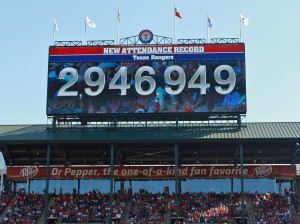
Video Boards
The team has gradually updated the quality (and size) of its video offerings. A 2003 update made the original board a little nicer and 2011’s massive HD upgrade took it up another level. This past season, left field ad signage went away to make room for another big TV. An electronic board also replaced the old manual out-of-town scoreboard in 2009.
Foul Poles
The Rangers had brought the old foul poles from Arlington Stadium when they moved, but swapped them out this season for new ones.
The Suit Sign
When the ballpark opened, it copied Brooklyn’s legendary Ebbets Field by displaying a Hit It Here and Win a Free Suit sign in an unhittable location in right field. Ad signage eventually replaced it and the west corner of the main video board currently occupies that space.
The Home Clubhouse
The average fan might not see it, except on a tour, but the Rangers did a big renovation to their players’ dressing area during the Buck Showalter era.
The Siemens Lot
This used to be a parking lot, then Arlington offered Siemens incentives to put in a facility, and then offered further incentives to Triumph Aerostructures to move in once Siemens left.
Jet Stream
There used to be a wind that supposedly blew home runs out to right field, abetted by the 2000 addition of what is now the Capital One Club behind home plate. Recent modifications seem to have reduced its effect.
Foul Territory
There used to be more of it. Expanded seats adjacent to the dugouts moved fans into the spots formerly occupied by infielders camping under a popup.
Concourse Space
When the park opened, it boasted wide-open concourses. New concession stands and promotional kiosks have reduced the walk space but added more ways to acquire beer.
The Boomstick
The hot dog named after Nelson Cruz wasn’t actually a permanent ballpark feature, it just seemed as big as one. I mention it to point out the team’s frequent changes to its concession configuration. Remember when they had a Starbucks on the first base side? Team employees flocked there during day games. The loss of the club-level Dublin Up pub that served Guinness on tap was a blow to me.
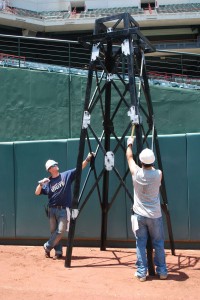
Oil Derrick
In 2011, the Rangers installed an old-school derrick to try to tap into some fossil fuel deposits underneath the ballpark soil. Team President Nolan Ryan also had them plant a pecan tree in the upper deck and brought in a herd of longhorns to graze the outfield grass. At least, that’s what happened according to series of commercials I created.
Globe Life Park’s David Schwarz-designed stylings look more or less the same as they did when the facility opened. The exterior reliefs, the brick, and the arches give it much the same feel as it had on April 11, 1994. Will it retain that feel if it transitions into a shopping center? It’s handled transitions before.


